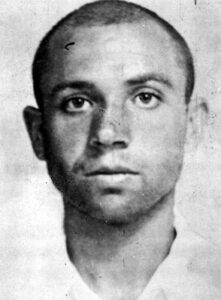Nicolas Roberto Robles
Badajoz, Spain

Miguel Hernández was born on October 30, 1910, in Orihuela (Alicante, Spain). His father, Miguel Hernández Sánchez, was a cattle dealer, and his mother, Concepción Gilabert Giner, did the housework and took care of their four children. Miguel had very few years of schooling. At the age of four, he attended a kindergarten but only for six months. At the age of eight he entered the Ave Maria Schools and at twelve the Santo Domingo School. But a year and a half later, in March 1925, he left school because his father wanted him to work as a shepherd. However, he secretly maintained his interest in reading and cultural education, frequently visiting the library of the priest Luis Almarcha, where he studied the classics. His first literary incursion into poetry was around 1925.
In 1933 he published his first book of poems, Perito en Lunas, which did not meet the success he expected. He settled in Madrid in 1935 in search of the recognition that eluded him. When he got a job working on the encyclopedia Los Toros, which the businessman José María de Cossío was preparing for Espasa-Calpe, he entered the literary elite of the Generation of ’27. This coincided with a change in his personality and a break from his religious beliefs.
At the outbreak of the Civil War, he joined the Communist Party. By 1937 he was a military political commissar. He joined the 5th Regiment under the command of “El Campesino” and fought at the front at Madrid, Andalusia, Extremadura, and Aragon. Surprisingly, as a communist commissar, he wrote “Para la Libertad,” one of the best poems about liberty in the Spanish language.
Para la libertad sangro, lucho, pervivo.
Para la libertad, mis ojos y mis manos,
como un árbol carnal, generoso y cautivo,
doy a los cirujanos.
For freedom I bleed, I struggle, I live.
For freedom, my eyes and my hands,
like a carnal tree, generous and captive,
I give to the surgeons.
On March 9, 1937, he married Josefina Manresa in a civil ceremony. His first son, Manuel Ramón, died in the fall of 1938. The war was practically lost, and Hernandez feared death and prison. His bitterness was relieved only by the news of the birth of his second son, Manuel Miguel.
When the war ended, he tried to escape on foot across the Portuguese border. He was arrested and began a prison journey that took him to Huelva, Seville, Torrijos (Madrid), Orihuela, Madrid again, Palencia, Ocaña, and Alicante. He was sentenced to death, which was later commuted to thirty years in prison through the influence of Jose Maria de Cossio and Dionisio Ridruejo, a poet member of Falange.1
In Alicante he fell ill, first with bronchitis and then typhus. Both were complicated by the reactivation of tuberculosis. The intervention of the painter Miguel Abad Miró2 allowed him to receive specialized medical care from the director of the Anti-Tuberculosis Dispensary of Alicante, Antonio Barbero Carnicero, who twice drained an empyema of the left lung. Unfortunately the permission to transfer him to the Anti-Tuberculosis Hospital “Porta Coeli” in the province of Valencia came too late. In his last moments, Miguel confirmed his civil marriage with Josefina in a religious ceremony in the prison infirmary. He died on March 28, 1942, at only thirty-one years of age.3
For a friend’s death, he composed this famous elegy:
Alimentando lluvias, caracolas
y órganos mi dolor sin instrumento,
a las desalentadas amapolas
daré tu corazón por alimento.
Tanto dolor se agrupa en mi costado,
que por doler me duele hasta el aliento.
My grief without purpose feeding
the rain, the snail-shells and organs,
I’ll give your heart for food
to the desolate poppies.
Such sorrow gathers in my chest,
that I mourn with painful breath.
References
- Ferris JL. Miguel Hernández. Pasiones, cárcel y muerte de un poeta. Sevilla: Fundación José Manuel Lara, 2016.
- Mestre Molto JA. Miguel Abad, pintor. Valencia: Institut Alfons el Magnanim, 2007.
- Manresa J. Recuerdos de la viuda de Miguel Hernández. Madrid: Ediciones de la Torre, 2010.
NICOLAS ROBERTO ROBLES is professor of Nephrology at the University of Extremadura (Badajoz) and member of the Academy of Medicine of Extremadura.
Highlighted in Frontispiece Volume 16, Issue 1 – Winter 2024

Leave a Reply